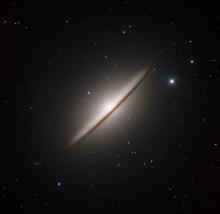Listen to today's episode of StarDate on the web the same day it airs in high-quality streaming audio without any extra ads or announcements. Choose a $8 one-month pass, or listen every day for a year for just $30.
You are here
VY Canis Majoris
One of the most extreme stars in the galaxy is extremely busy. Every few decades, it puffs out a giant blob of hot gas. The blob cools and condenses to form a cloud of dust. The cloud then passes in front of the star, making it look much fainter.
VY Canis Majoris is in Canis Major, the big dog, which is in the south at dawn this month. The constellation hosts the brightest star in the night sky, Sirius.
VY Canis Majoris is much fainter — to the eye, anyway. It’s actually one of the brighter stars in the entire Milky Way Galaxy — more than a quarter of a million times as bright as the Sun. The star also is about 1400 times wider than the Sun. If it took the Sun’s place, it would extend beyond the orbit of Jupiter, the fifth planet out. It’s also much more massive than the Sun.
We can’t see the star because of its activity. It’s late in life, in a phase where bubbles of gas as big as the Sun percolate toward the surface. When they reach the surface, some of the gas flies out into space. It eventually cools and forms a cloud of dark dust.
That appears to have happened at least four times in the last 250 years. Each time, the star grew much fainter. The most recent event has obscured the star so much that it’s too faint to see without a telescope.
This phase might not last long. Soon, VY Canis Majoris might get smaller and hotter. Eventually, it might collapse to form a black hole — a dark remnant of a mighty star.
Script by Damond Benningfield





